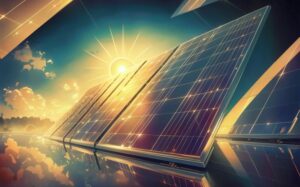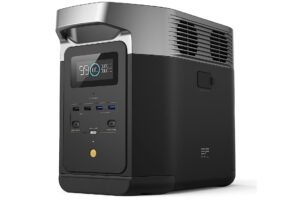SEIA’s outgoing chair on COVID, Auxin, and the path forward
Woodland Solar, Isle of Wight, Finished Installation of tracking system with PV modules (Courtesy: Dominion Virginia)
George Hershman, the CEO of SOLV Energy, a leading utility-scale solar EPC firm, joined Episode 66 of the Factor This! podcast to take us inside the critical behind-the-scenes deliberations that helped save solar. Subscribe wherever you get your podcasts.
George Hershman’s term as chair of solar’s leading trade group began with optimism and excitement.
Hershman had been one of the longest-serving members on the board of the Solar Energy Industries Association, or SEIA. As chair, he would be charged with accelerating the solar industry’s meteoric growth, while helping spearhead the next generation of clean energy policy.
It was January 2020.
A global pandemic, supply chain constraints, and a potentially existential tariff fight made even the “solar coaster” moniker appear ill-equipped to describe what happened next. But Hershman’s tenure, while filled with unprecedented challenges, also featured a legacy-defining policy win.
Nearly four years on, and on the verge of vacating his chairmanship, Hershman joined the Factor This! podcast to recount what arguably has been the most tumultuous chapter in solar’s topsy-turvy story.
Hershman recounted SEIA’s own battle for survival, reflected on a less-than-subtle spat with the Biden administration in the Auxin Solar tariff fight, and delighted in remembering the Inflation Reduction Act’s breakthrough moment.
SAVE THE DATE! The next edition of the GridTECH Connect Forum will be held in Orlando, Florida on February 26, 2024. We’re bringing together developers, utilities, and regulators to take on the critical issue of DER interconnection in the Southeast. Register to secure your seat today.
‘We want to work’
As the pandemic set in, and it was evident that life would be disrupted for longer than a few weeks, SEIA’s lobbying heft was wholly redirected to getting solar companies back to work.
Inherent to solar project construction is the outdoor office and an ability to socially distance, the organization argued. That argument led to a determination by federal labor officials that solar development held essential work status.
But SEIA wasn’t only concerned with the survival of its members. Restrictions on in-person gatherings meant the annual conference of more than 30,000 clean energy professionals, couldn’t operate. A big chunk of the organization’s revenue evaporated in an instant.
“We started to think through how is this business going to survive?” Hershman said. “It was a unique time where companies truly came together.”
That meant tough decisions, including layoffs. But it allowed solar’s voice to persevere, and take on the myriad of battles that quickly followed.
Auxin Solar
The Commerce Department’s announcement in March 2022 that it would investigate tariff circumvention claims by a small U.S. manufacturer, Auxin Solar, brought the industry to a screeching halt.
Auxin alleged that manufacturers in Southeast Asia, which account for around 80% of U.S. solar module supplies, were evading tariffs imposed on China years earlier. The threat of retroactive penalties throttled imports for months.
SEIA, in coordination with other clean energy trade groups, shifted its ire from Auxin to the Biden administration. The coalition asserted that the White House was betraying its own climate ambitions by allowing the case to proceed.
The groups dedicated $5 million to the highly public spat with President Biden, despite Commerce Secretary Gina Raimando’s argument that the investigation was required under U.S. trade law.
Hershman defended the approach by SEIA, and others, saying Commerce could have approached the case with a “scalpel” instead of a “sledgehammer.”
“It is the obligation of Commerce to look at (the petition). It is not the obligation of Commerce to continue an investigation,” Hershman said.
SEIA succeeded in its pressure campaign. Biden paused for two years any new tariffs on modules imported from Southeast Asia— a reprieve from the investigation and a bridge to ramping up domestic manufacturing as incentives moved through Congress.
Ultimately, Commerce determined that some solar manufacturers in Southeast Asia were, in fact, skirting tariffs. And new penalties seem likely once the president’s moratorium sunsets next June (Biden has indicated he has no plans to extend the tariff pause).
Few will argue that tariffs, on their own, support a strong domestic manufacturing base. But coupled with sound industrial policy, one may just be able to take shape for solar. And that lifeline would come only a few months later in the Inflation Reduction Act.
Watch the full episode on YouTube
Inflation Reduction Act
Biden’s legacy-defining climate proposal, Build Back Better, had promised billions for clean energy and domestic manufacturing. But it had suffered several painful deaths over the course of a year at the hands of Sen. Joe Manchin, the senior Democrat from West Virginia, and appeared doomed for the ash heap of history.
Then, on July 27, 2022, Manchin emerged from negotiations with Senate Majority Leader Chuck Schumer (D-NY) with a deal: legislation to quell the impacts of rising costs of energy and pharmaceuticals would also include nearly $400 billion to fight climate change.
“I don’t remember where I was and what happened when we finally got to the finish line,” Hershman said with a laugh. “Some of the most impactful moments for me were the body blows that came along the way.”
The road to the Inflation Reduction Act was long and, at times, demoralizing. But Hershman said he’s forever indebted to the congressional staffers who helped keep industry hopes alive.
The solar industry didn’t get everything on its wish list, though. For one thing, direct pay for tax credits remain a critical need to combat a strained tax equity finance market. For another, incentives to boost the nation’s inadequate transmission system for the demands of a rapidly decarbonizing grid wound up on the cutting room floor.
But what matters, in the end, is that solar survived, and seems positioned to thrive under the IRA.
“Like I talk to our interns that come in every year, this is the time to be joining a renewable company and being in the renewable industry,” Hershman said. “We have amazing things to do ahead of us, and the transition has begun.”




